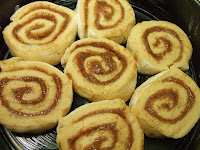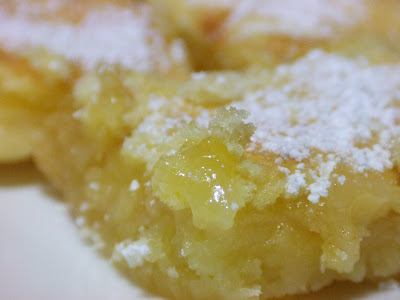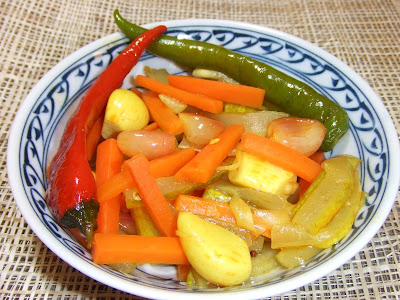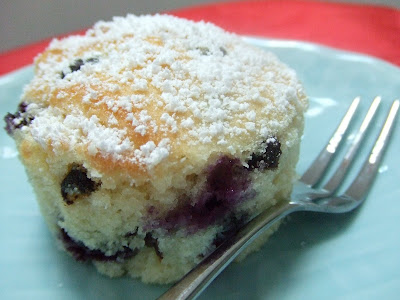 Interestingly enough this month's Daring Baker's challenge was a filbert gateau and our July host is Mele Cotte Her inspiration for this gateau comes from Great Cakes by Carol Walter, a book which she has had for quite a while now.
Interestingly enough this month's Daring Baker's challenge was a filbert gateau and our July host is Mele Cotte Her inspiration for this gateau comes from Great Cakes by Carol Walter, a book which she has had for quite a while now.A gateau (pronounced as ga-toe) is a French cake, often specifically a sponge cake that may be made from almond flour instead of wheat flour.
When I read the instructions to making this month's challenge, first thoughts that came to mind was "geez ... this is another long set of instructions". After having read it a few times, I realized that the preparation could be broken down into different stages and made over a few days. But rather than waste the entire week-end, I decided to cramp everything into a Saturday and also modify the recipe. Instead of hazelnuts, I used almonds instead. I decided not to add the whipped cream which was in the original receipe - I don't really like too much cream in my cakes! I also omitted doing a praline buttercream and instead settled on an orange marmalade (with chunky bits in the jam) buttercream frosting. Chocolate ganache and orange. This should be a nice combination!
On Saturday morning, my husband and I woke up early and did our morning exercise - a 5 km walk followed by breakfast. We popped into a nearby supermarket to get the rest of my ingredients before heading for home. I started on the challenge about lunch time and if everything goes according to plan, I should be finish way before dinner time. Lo and behold .. I didn't know what was in store for me that afternoon!
I followed the recipe to the teeth and eagerly poured the cake batter into my 9" pan. It rose well in the oven but 25 minutes into baking time, the gateau started to go lop-sided and had a slight depression. Oh no I hope it's not going to be a cave-in! By the time it was done, it sank some more! I almost cried! No way in hell could I get 3 layers of cake from that! Whatever shall I do! Breathe! Breathe!

I calmed myself and decided I'll do another batch of batter. Whilst the 2nd gateau was baking in the oven, I started on my syrup, glaze and buttercream. The 2nd gateau faired slightly better than the first - but still not up to expectation. Okay at least now I have 2 gateau which I could cut in half and have 4 layers. I put them aside to cool. Next item on the agenda was the ganache. I took out the bottle of cream from the fridge which I had purchased earlier in the week. Poured it out into a bowl and got a whiff ... what, don't tell me it's off! Sure enough it was. It was already late and I was not in the mood to go out and get another bottle of cream. This will have to wait until the next day.

My strategy on Sunday was pretty clear and simple, or so I thought. I just needed to cut the gateau, brush it with syrup, add the buttercream, make the ganache and finish off the decoration. I proceeded to slice the first gateau, brushed it with syrup and added the buttercream. I then worked on the 2nd piece, brushed with syrup and in my haste to put the gateau on top of the other 2 pieces, it slipeed and fell onto the table. Because it was thin and slightly moist with the syrup, it broke into several pieces. How much more bad luck do I need! Not much else I could do but to end up with a 3-layer gateau instead of 4. Luckily after this, everything else went smoothly.
Final result - the gateau tasted fantastic and I must say that the chocolate and orange marmalade paried off very well. My husband who is not a cake fan said that this is "the best ever" - and that's quite a lot coming from a non-cake person! He had a slice in the evening and asked for MORE. I couldn't believe it!
Thank you Melle Cotte for choosing this recipe. It has certainly been more than a "challenge" for me.

Almond Gateau
Ingredients for the Gateau:
1 1/2 cups almonds, toasted/skinned
2/3 cup cake flour, unsifted
2 Tbsp cornstarch
7 large egg yolks
1 cup sugar, divided into 3/4 and 1/4 cups
1 tsp vanilla extract
1 Tbsp grated orange rind
5 large egg whites
1/4 cup warm, clarified butter (100 - 110 degrees). Alternatively you can use ghee
Method:
1) Position rack in the lower 3rd of the oven and preheat to 175 or 350 degrees. Grease and flour a 10” X 2” inch round cake pan.
2) Using a food processor, process nuts, cake flour, and cornstarch for about 30 seconds. Then, pulse the mixture about 10 times to get a fine, powdery mixture. You’ll know the nuts are ready when they begin to gather together around the sides of the bowl. While you want to make sure there aren’t any large pieces, don’t over-process. Set aside.
3) Put the yolks in the bowl of an electric mixer, with the whisk attachment, and beat until thick and light in color, about 3-4 minutes on med-high speed. Slowly, add 3/4 cup of sugar. It is best to do so by adding a tablespoon at a time, taking about 3 minutes for this step. When finished, the mixture should be ribbony. Blend in the vanilla and grated orange rind. Remove and set aside.
4) Place egg whites in a large, clean bowl and with an electric mixer beat on medium speed, until soft peaks. Increase to med-high speed and slowly add the remaining 1/4 cup of sugar, over 15-20 seconds or so. Continue to beat for another half a minute.
5) Add the yolk mixture to the whites and whisk for 1 minute.
6) Pour the warm butter in a liquid measure cup (or a spouted container). * It must be a deep bottom bowl and you must work fast.* Working quickly, sprinkle about 2 Tbsp of the almond meal at a time onto the mixture – folding it carefully for about 40 folds. Be sure to exclude any large chunks/pieces of nuts. Again, work quickly and carefully so as not to deflate the mixture. When all but about 2 Tbsp of almond meal remain, quickly and steadily pour the warm butter over the batter. Then, with the remaining almond meal, fold the batter to incorporate, about 13 or so folds.
7) With a rubber spatula, transfer the batter into the prepared pan, smoothing the surface with the spatula or back of a spoon. **If any collected butter remains at the bottom of the bowl, do not add it to the batter! It will impede the cake rising while baking.**
8) Tap the pan on the counter to remove air bubbles and bake in the preheated oven for 30-35 minutes. You’ll know the cake is done when it is springy to the touch and it separates itself from the side of the pan. Remove from oven and allow to stand for 5 minutes. Invert onto a cake rack sprayed with nonstick coating, removing the pan. Cool the cake completely.
*If not using the cake right away, wrap thoroughly in plastic wrap, then in a plastic bag, refrigerator for up to 3 days. If freezing, wrap in foil, then the bag and use within 2-3 months.
Orange Honey Syrup:
1/2 cup honey
3 Tbsp orange juice
Mix the honey and orange juice together. Microwave for 1/2 minute. Cool slightly before using on the cake. The syrup can be made in advance.
Orange Buttercream Frosting:
1 stick butter, room temperature
2/3 cup of orange marmalade (try to find one with orange bits in it)
3 cups powdered sugar
2 Tbsp heavy cream
1 tsp vanilla extract
1 tsp orange extract or essence
Beat butter until creamy. Add in the marmalade. Beat in powdered sugar. Then add in the cream, followed by vanilla and orange extract. If using immediately, refrigerate 10-15 minutes first.
Otherwise the buttercream can be made earlier. Refrigerate buttercream in an airtight container for up to 5 days, or can be frozen for up to 6 months. If freezing, store in plastic containers and thaw in the refrigerator overnight or at room temperature for several hours. Stir the cream a few times before using.
Orange Marmalade Glaze:
2/3 cup thick orange marmalade preserves
1 Tbsp water
In a small saucepan, bring the water and preserves to a slow boil and simmer for 2-3 minutes. If the mixture begins to stick to the bottom of the saucepan, add water as needed.
Remove from heat and, using a strainer, press the mixture through the mesh and discard any remnants. With a pastry brush, apply the glaze onto the cake. If the glaze is too thick, thin to a preferred consistency with a few drops of water.
Ganache Glaze:
Makes about 1 cup, enough to cover the top and sides of a 9 or 10 inch layer
6 oz. bittersweet chocolate
6 oz. (3/4 cup) heavy cream
1 Tbsp light corn syrup
3/4 tsp vanilla
1/2 - 1 tsp hot water, if needed
1) Break the chocolate into 1-inch pieces and place in a bowl.
2) Heat the cream, vanilla and corn syrup in a saucepan, on low, until it reaches a gentle boil. Remove from stove and carefully pour over the chocolate. Leave it alone for one minute, then slowly stir and mix the chocolate and cream together until all the chocolate melts and is incorporated into the cream. If the surface of the ganache seems oily, add 1/2 - 1 tsp hot water. The glaze will thicken, but should still be pourable. If it doesn’t thicken, refrigerate for about 5 minutes, but make sure it doesn’t get too cold!
To Assemble the Gateau:
1) Cut two cardboard disks slightly larger than the cake. Divide the cake into 3 layers and then using a sharp serrated knife or cake leveller cut each layer, one at a time. Using the cardboard disk, gently slide under each layer away and set aside. Then using the same method, cut the 2nd layer. Using a pastry brush, moisten the cut side of the cake with 3-4 Tsp of warm sugar syrup.
2) Divide the buttercream into 2 containers. Using the first half, spread the bottom layer with a 1/4" thickness of the buttercream. Place the middle layer over the first, brush with sugar syrup and then cover with the remaining buttercream.
3) Gently, press the sides of the cake to align the layers. Refrigerate to chill for at least 30 minutes.
4) Remove the cake from the refrigerator. Holding a serrated or very sharp knife with an 8-ich blade held parallel to the sides of the cake, trim the sides of the cake so that they are perfectly straight. Brush the top and sides of the cake with warm orange marmalade glaze, sealing the cut areas completely. Re-chill the cake in the refridgerator whilst preparing the ganache.
5) Place a rack over a large shallow pan to catch the ganache drippings. Remove the gateau from the refrigerator and put it the rack. With a metal spatula in hand, pour the ganache onto the cake’s center. Move the spatula over the top of the ganache about 4 times to get a smooth and mirror-like appearance. The ganache should cover the top and run down the sides of the cake. When the ganache has been poured and is coating the cake, lift one side of the rack and bang it once on the counter to help spread the ganache evenly and break any air bubbles. (Work fast before setting starts.) Patch any bare spots on the sides with a smaller spatula, but do not touch the top after the “bang”. Refrigerate the gateau for 30 mins to an hour in order for the ganache to set.
6) Remove the gateau from the fridge. Using tip # 16 pipe the bottom sides of the gateau with shell design. Using a large star tip, pipe stars on the top of the gateau. Decorate the sides of the gateau with chocolate wafers.
7) Leftover cake can be covered with foil and kept in the refrigerator for up to 5 days.


























